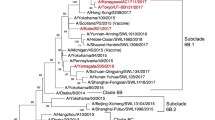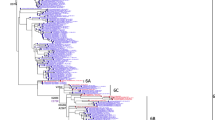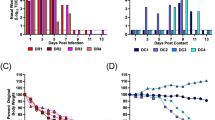Abstract
Pandemic (H1N1) 2009 virus has been causing major concerns around the world because of its epidemic potential, rapid dissemination, rate of mutations, and the number of fatalities. One way to gain an advantage over this virus is to use existing rapid bioinformatics tools to examine easily and inexpensively generated genetic sequencing data. We have used the protein sequences deposited with the National Center for Biotechnology Information (NCBI) for data mining to study the relationship among the Pandemic (H1N1) 2009 proteins. There are 11 proteins in the Pandemic (H1N1) 2009 virus, and analysis of sequences from 65 different locations around the globe has resulted in two major clusters. These clusters illustrate the Pandemic H1N1 2009 virus is already experiencing significant genetic drift and that rapid worldwide travel is affecting the distribution of genetically distinct isolates.
Similar content being viewed by others
Article PDF
Author information
Authors and Affiliations
Corresponding author
Rights and permissions
About this article
Cite this article
Wick, C., Stanford, M., Jabbour, R. et al. Pandemic (H1N1) 2009 Cluster Analysis: A Preliminary Assessment. Nat Prec (2009). https://doi.org/10.1038/npre.2009.3773.1
Received:
Accepted:
Published:
DOI: https://doi.org/10.1038/npre.2009.3773.1



